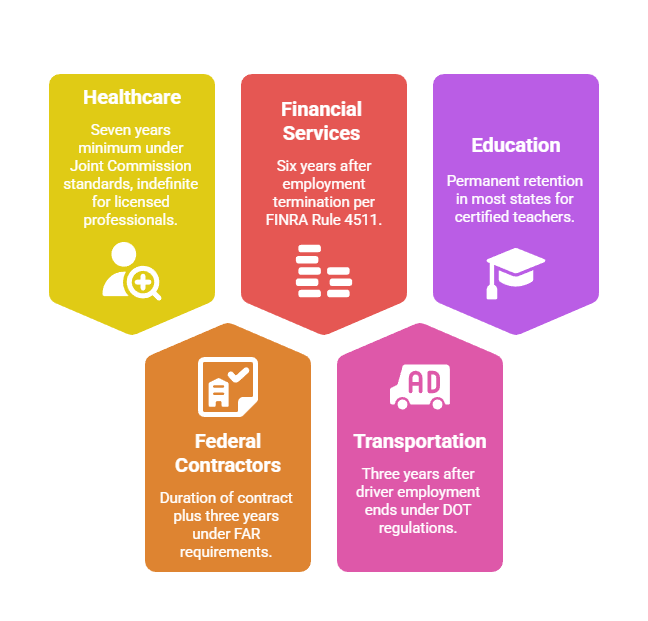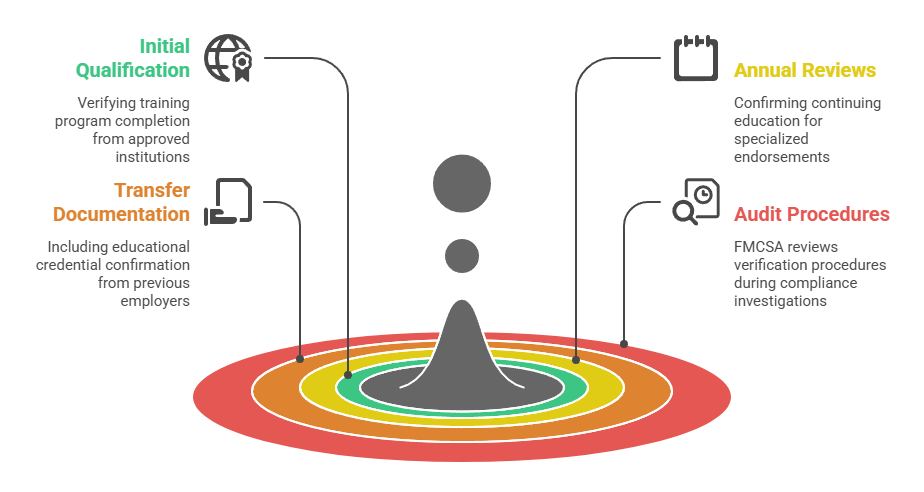High school diploma verification requirements vary significantly across industries, with highly regulated sectors like healthcare, transportation, and financial services facing strict federal mandates while others maintain voluntary standards. Understanding these industry-specific requirements is critical for compliance officers and HR directors to avoid penalties ranging from $10,000 to $1 million per violation, depending on the regulatory framework governing their sector.
Key Takeaways
- Healthcare organizations must verify all clinical staff credentials under 42 CFR § 482.12, with penalties up to $10,000 per day for non-compliance with CMS conditions of participation.
- DOT-regulated transportation companies face mandatory education verification for commercial drivers under 49 CFR § 391.21, with violations resulting in $16,864 fines per occurrence and potential loss of operating authority.
- Federal contractors with agreements exceeding $150,000 must conduct education verification following FAR 52.222-46 guidelines, risking contract termination and debarment for falsified credentials.
- Financial services firms under FINRA Rule 1010 must verify educational backgrounds for registered representatives, with failure resulting in registration denials and potential sanctions.
- K-12 educational institutions in all 50 states require diploma verification for teachers, with state-specific credential fraud penalties ranging from misdemeanors to felony charges.
- Manufacturing and retail sectors maintain voluntary verification standards unless handling sensitive materials or data, allowing flexible policies based on role sensitivity.
- State-level variations affect verification depth, with 23 states requiring specific affidavits or notarized documents for positions involving vulnerable populations.
- 2025 regulatory updates include enhanced digital verification standards under revised E-Verify protocols and expanded healthcare verification requirements following the Consolidated Appropriations Act amendments.
Understanding the Regulatory Framework for Education Verification
The landscape of high school diploma verification requirements has evolved dramatically since the implementation of comprehensive background check legislation in the 1990s. Federal and state regulations now create a complex matrix of obligations that vary by industry, job function, and geographic location. Compliance officers must navigate multiple regulatory frameworks simultaneously, as many organizations operate across industry boundaries or hold multiple regulatory designations.
Federal vs. State Verification Standards
Federal verification requirements establish baseline standards for specific industries under direct government oversight. The Fair Credit Reporting Act (FCRA) governs how employers must conduct background checks, including education verification, requiring written consent and adverse action procedures. However, FCRA doesn't mandate verification itself—that obligation comes from industry-specific regulations.
State laws add another layer of complexity to the verification process. Thirty-seven states maintain specific statutes addressing credential fraud and verification protocols, creating different requirements for employers operating in multiple jurisdictions. Multi-state employers must comply with the most restrictive applicable standard to maintain consistent hiring practices across all locations.
Documentation and Record Retention Requirements
Organizations should maintain detailed verification records as evidence of due diligence during regulatory audits. These records must include the verification method used, date completed, source contacted, and results obtained. Additionally, documentation serves as protection if credential fraud is later discovered, potentially mitigating penalties.
Retention periods vary significantly by industry and regulatory framework:

- Healthcare sector: Seven years minimum under Joint Commission standards, indefinite for licensed professionals
- Federal contractors: Duration of contract plus three years under FAR requirements
- Financial services: Six years after employment termination per FINRA Rule 4511
- Transportation industry: Three years after driver employment ends under DOT regulations
- Education sector: Permanent retention in most states for certified teachers
Record-keeping systems must ensure easy retrieval during audits. Digital storage solutions should include backup procedures and access controls to protect sensitive employee information while maintaining compliance readiness.
Healthcare Industry Education Verification Requirements

Healthcare represents the most stringently regulated sector for education verification, with overlapping federal, state, and accreditation body requirements. The Centers for Medicare & Medicaid Services (CMS) Conditions of Participation mandate that hospitals verify credentials for all staff providing patient care. Specialized roles face additional verification from professional licensing boards, creating multiple checkpoints for credential authenticity.
Clinical Staff Verification Under Federal Law
Title 42 CFR § 482.12(a)(7) requires hospitals participating in Medicare to verify the education credentials of all clinical staff before granting privileges or employment. This includes physicians, nurses, allied health professionals, technicians, and anyone with direct patient contact. Verification must be documented within the employee's permanent file and updated when credentials change or expire.
The Joint Commission enforces Standard HR.01.02.05 requiring primary source verification of education within specified timeframes. Primary source verification means contacting the educational institution directly rather than accepting diplomas or transcripts provided by candidates. Third-party verification services approved by the National Association of Professional Background Screeners (NAPBS) satisfy this requirement when they maintain direct institutional relationships.
State-Specific Healthcare Verification Protocols
Individual states layer additional requirements atop federal standards, particularly for long-term care facilities and home health agencies. These state requirements often exceed federal minimums, creating more stringent compliance obligations for healthcare employers. Twenty-three states now require healthcare facilities to use state-managed databases for credential verification, creating standardized processes but adding complexity for multi-state operators.
| State | Specific Requirement | Penalty Range |
| New York | 10 NYCRR § 1001.11 - Criminal background checks with integrated education verification | $2,000-$10,000 per violation |
| Massachusetts | 105 CMR 155.003 - Notarized affidavits attesting to credential authenticity | License suspension or revocation |
| California | Title 22 requirements - Primary source verification for all licensed staff | $100-$25,000 per violation |
| Texas | Health and Safety Code § 242.015 - Pre-employment verification for nursing facilities | $500-$5,000 per occurrence |
Penalties for credential fraud in healthcare settings include both civil fines and potential criminal prosecution. Recent cases have resulted in settlements exceeding $500,000 for systematic verification failures, demonstrating the serious consequences of non-compliance.
Transportation and DOT-Regulated Industries

The Department of Transportation maintains comprehensive education verification requirements for safety-sensitive positions, recognizing that inadequately trained operators pose significant public safety risks. These requirements extend beyond commercial drivers to include aviation personnel, railroad operators, and hazardous materials handlers. Compliance ensures that individuals operating vehicles and equipment meet minimum competency standards.
Commercial Driver Education Verification (49 CFR § 391.21)
Motor carriers must verify that commercial driver applicants meet minimum education standards as part of the driver qualification file required under 49 CFR § 391.21. While this regulation doesn't mandate high school diploma verification for all drivers, it requires documentation of training completion and reading comprehension ability. Hazmat endorsement applicants must demonstrate literacy through standardized testing, effectively creating an indirect education verification requirement.
Recent regulatory updates following the Drug and Alcohol Clearinghouse implementation in 2020 have increased scrutiny on all qualification documentation:

- Initial qualification files: Must contain verification of training program completion from approved institutions
- Annual reviews: Carriers must confirm continuing education requirements for specialized endorsements
- Transfer documentation: Previous employer verification must include educational credential confirmation
- Audit procedures: FMCSA reviews verification procedures during compliance investigations
Motor carriers face heightened liability in accident litigation when driver qualification files lack complete education verification. Violation fines reach $16,864 per occurrence, and systematic failures can result in operating authority suspension or revocation.
Aviation and Railroad Personnel Standards
Federal Aviation Administration regulations under 14 CFR Part 65 require education verification for aircraft mechanics, repairmen, and dispatchers seeking certification. The FAA maintains centralized records but requires applicants to submit authenticated educational transcripts showing completion of approved training programs. Falsification of these records results in immediate certificate revocation and federal prosecution under 18 U.S.C. § 1001.
Railroad personnel under Federal Railroad Administration oversight must meet education standards specified in 49 CFR Part 243. Locomotive engineers and conductors must demonstrate reading comprehension and basic mathematics skills through FRA-approved testing. These functional requirements create education verification obligations regardless of formal credential status.
Federal Contractors and Government Employment

Organizations holding federal contracts face education verification requirements that scale with contract value and security clearance levels. The Federal Acquisition Regulation (FAR) establishes baseline standards, while individual agencies add supplementary requirements for sensitive positions. Compliance protects both the organization and the federal government from security risks associated with credential fraud.
FAR Education Verification Standards
FAR 52.222-46 requires federal contractors to conduct background checks on employees working on covered contracts, with education verification included in the investigation scope. Contracts exceeding $150,000 require enhanced verification procedures, including confirmation that credentials were issued by accredited institutions. Defense contractors face the most stringent requirements under the National Industrial Security Program Operating Manual (NISPOM).
Personnel requiring security clearances undergo comprehensive background investigations including verified education histories back to high school. Inconsistencies in educational records frequently result in clearance denials or revocations. Investigators examine whether claimed credentials match verified records, assess any gaps in education history, and evaluate explanations for discrepancies.
Agency-Specific Requirements and Security Clearances
Individual federal agencies maintain supplementary verification standards exceeding baseline FAR requirements. The Department of Homeland Security requires diploma verification for all direct employees regardless of position under DHS Directive 250-04. The Department of Energy mandates verification for anyone accessing facilities or information systems.
Security clearance investigations conducted by the Defense Counterintelligence and Security Agency (DCSA) include education verification as standard investigative elements:
- Confidential clearances: Verify education for past seven years
- Secret clearances: Verify education for past ten years
- Top Secret clearances: Verify all education back to high school
- SCI access: Verify all education with enhanced primary source methods
Investigation reports document any discrepancies between claimed and verified credentials. Unexplained inconsistencies often result in clearance denial regardless of other favorable factors, as they raise questions about honesty and vulnerability to coercion.
Financial Services and Banking Sector Requirements

Financial services firms operate under multiple regulatory frameworks requiring education verification to protect consumers and ensure industry competency. Requirements stem from both self-regulatory organizations like FINRA and direct government oversight from agencies including the SEC, FDIC, and state banking regulators. These verification obligations help maintain public trust in financial institutions.
FINRA Registration and Education Verification
FINRA Rule 1010 requires member firms to verify the educational background of all associated persons before filing registration applications. While the rule doesn't mandate minimum education levels for most registrations, firms must confirm that claimed credentials are authentic and issued by legitimate institutions. Form U4, the uniform registration application, requires detailed education history including institution names, attendance dates, and degrees obtained.
Member firms face disciplinary action for submitting registration applications containing unverified or false information. Recent enforcement actions have resulted in significant financial penalties and reputational damage. Individual representatives who falsify educational credentials face permanent industry bars and potential criminal prosecution under securities fraud statutes.
| Violation Type | Firm Penalty | Individual Consequence |
| Single unverified credential | $10,000-$50,000 | Suspension 30-90 days |
| Pattern of verification failures | $100,000-$500,000 | Permanent bar from industry |
| Knowing falsification | $500,000+ | Criminal prosecution, permanent bar |
Bank Employment and FDIC Section 19
The FDIC enforces Section 19 of the Federal Deposit Insurance Act, which prohibits individuals with criminal convictions from working in banking without regulatory approval. While Section 19 primarily addresses criminal history, implementing regulations require banks to conduct comprehensive background checks including education verification. This ensures that employees handling customer funds and sensitive financial information meet basic competency standards.
State banking regulators add supplementary requirements, with some states mandating notarized credential verification for specific positions. Compliance officers, anti-money laundering specialists, and senior management typically face enhanced verification requirements reflecting their critical roles. Documentation must be maintained throughout employment and made available during regulatory examinations.
Education Sector Background Verification

The education sector itself maintains some of the most comprehensive credential verification requirements, recognizing that teacher qualifications directly impact student outcomes. All 50 states require diploma verification as part of teacher certification, with many extending requirements to administrators, counselors, and support staff. These requirements protect students and maintain professional standards within the education workforce.
Teacher Certification and State Requirements
State education agencies manage teacher certification processes that universally include education verification. Most states require applicants to submit official transcripts directly from degree-granting institutions to state certification offices. These transcripts must show completion of state-approved teacher preparation programs and minimum GPA requirements, typically 2.5 or higher.
The Interstate Teacher Mobility Compact, adopted by 13 states as of 2025, creates reciprocal certification recognition but maintains individual state verification requirements. Teachers relocating between member states must still provide verified credentials to new jurisdictions, though the process is streamlined. Non-member states require complete re-verification regardless of previous state certifications.
K-12 Support Staff and Administrator Verification
Education verification extends beyond teachers to include multiple role categories within school systems. Each position type faces specific requirements based on student contact level and supervisory responsibilities. The Every Student Succeeds Act (ESSA) requires paraprofessionals in Title I schools to hold at least a high school diploma or equivalent, with verification documented in district personnel files.
Key positions requiring verification include:

- Principals and superintendents: Advanced degree verification from regionally accredited institutions approved for educational leadership programs
- School counselors: Master's degree verification plus state certification credential confirmation
- Librarians and media specialists: Bachelor's degree minimum with specialized certification verification
- Paraprofessionals: High school diploma or associate degree depending on state requirements
- Substitute teachers: Same verification standards as full-time teachers in 43 states
State laws often exceed federal minimums, with 18 states requiring associate degrees or higher for paraprofessional positions regardless of funding source. Support staff positions involving student contact face varying requirements by state, but the trend toward stricter standards continues.
Industry-Specific Decision Framework for HR Teams
Determining appropriate verification depth requires analyzing multiple factors including regulatory obligations, role sensitivity, and risk tolerance. This decision framework helps compliance officers and HR directors establish consistent policies aligned with legal requirements while managing verification costs. A structured approach ensures comprehensive compliance without unnecessary expenditure on positions with minimal regulatory exposure.
Risk Assessment Matrix for Verification Depth
Organizations should categorize positions into verification tiers based on specific criteria that reflect regulatory and operational risk. This tiered approach balances compliance obligations against verification costs, which range from $15-$30 per candidate for basic database checks to $75-$150 for comprehensive primary source verification. Multi-state employers must apply the most restrictive standard when positions operate across jurisdictions with varying requirements.
Comprehensive Primary Source Verification - Tier 1
- Healthcare positions involving direct patient care or clinical decision-making
- DOT safety-sensitive positions including commercial drivers and dispatchers
- Federal contractor positions requiring security clearances
- Financial services roles requiring FINRA registration or fiduciary responsibilities
- Education positions requiring state certification or involving direct student instruction
Database Verification with Audit Procedures - Tier 2
- Supervisory positions without direct regulatory requirements but involving data access
- Roles handling confidential customer or employee information
- Positions with indirect patient, student, or client contact
- Management positions with budget authority or contract signing power
Self-Certification with Random Audit - Tier 3
- Entry-level positions with no regulatory requirements
- Roles without access to sensitive information or vulnerable populations
- Temporary or seasonal positions under six months duration
- Contractor positions where the contracting agency verifies credentials
Documentation systems should flag positions subject to multiple regulatory frameworks. This ensures verification procedures address all applicable requirements and maintains clear audit trails for compliance reviews.
Overlapping Industry Scenarios and Compliance Priorities
Many organizations operate in multiple industries simultaneously, creating overlapping verification obligations that require careful analysis. A hospital system operating a retail pharmacy faces both healthcare regulations under CMS and pharmacy-specific requirements under state boards of pharmacy. When requirements conflict or overlap, organizations must apply the most stringent standard to ensure comprehensive compliance.
Annual compliance audits should review a sample of verification files across all position categories. These audits confirm that procedures remain current with evolving regulations and identify gaps requiring policy updates. Verification policy updates should occur minimally on an annual cycle, with interim updates triggered by new legislation or regulatory guidance.
2025 Regulatory Updates and Compliance Best Practices
The regulatory landscape for education verification continues evolving, with several significant updates taking effect in 2025. These changes reflect technological advances in verification methods and policy responses to emerging fraud schemes. Staying current with these updates is essential for maintaining compliance and avoiding penalties.
Digital Verification Standards and E-Verify Integration
Updated E-Verify protocols implemented in January 2025 integrate education verification options for positions requiring specific credentials. Employers can now request that E-Verify compare education data against Department of Education databases when positions mandate minimum education levels for regulatory compliance. This optional enhancement streamlines verification for covered employers but doesn't eliminate obligations to conduct separate verification for highly regulated industries.
Blockchain-based credential verification systems have gained regulatory acceptance in multiple states:
- Digital diplomas: Twelve states authorize digital diplomas with cryptographic verification as satisfying primary source requirements
- National Student Clearinghouse expansion: Now includes high school diploma records for 78% of U.S. public high schools
- Blockchain consortiums: Education institutions in 15 states participate in distributed ledger systems for instant verification
- Mobile credentials: Digital wallets containing verified credentials accepted by federal agencies for contractor screening
However, regulatory guidance maintains that primary source verification through direct institutional contact remains the gold standard for positions under stringent regulatory oversight. Organizations should evaluate whether digital methods satisfy their specific regulatory requirements before implementing new verification technologies.
Penalty Frameworks and Enforcement Trends
Enforcement agencies have increased focus on credential verification compliance, with penalty assessments rising significantly over the past three years. Healthcare organizations faced $4.2 million in combined penalties during 2024 for verification failures discovered during routine CMS surveys. Transportation sector fines for inadequate driver qualification files totaled $2.8 million across 147 enforcement actions.
Pattern-and-practice investigations target organizations with systemic verification failures rather than isolated incidents. Regulators assess whether organizations maintain written verification policies, train HR staff on requirements, conduct periodic audits, and take corrective action when deficiencies are identified. Organizations demonstrating good-faith compliance efforts face reduced penalties compared to those lacking documented procedures, even when individual verification failures occur.
| Industry Sector | 2024 Total Penalties | Average per Violation | Most Common Deficiency |
| Healthcare | $4,200,000 | $10,500 | Missing primary source documentation |
| Transportation | $2,800,000 | $16,864 | Incomplete driver qualification files |
| Federal Contractors | $1,600,000 | $125,000 | Inadequate clearance investigation records |
| Financial Services | $3,100,000 | $45,000 | Unverified Form U4 information |
Conclusion
High school diploma verification requirements create a complex compliance landscape varying dramatically across industries and jurisdictions. Organizations in healthcare, transportation, financial services, and education face stringent federal and state mandates requiring primary source verification and detailed documentation. Other sectors maintain flexibility to establish risk-based policies aligned with their operational needs. The 2025 regulatory environment emphasizes documented procedures, regular audits, and good-faith compliance efforts as key factors in enforcement outcomes, making it essential for HR teams to understand applicable frameworks and implement appropriate verification protocols.
Frequently Asked Questions
What industries have mandatory high school diploma verification requirements?
Healthcare, transportation (DOT-regulated), K-12 education, federal contractors, and financial services face mandatory verification requirements under various federal and state regulations. Healthcare organizations must verify credentials under CMS Conditions of Participation, while DOT-regulated carriers follow 49 CFR § 391.21. Education sector verification is required for teacher certification in all 50 states, and federal contractors must comply with FAR standards.
How much do employers typically spend on education verification per candidate?
Education verification costs range from $15-$30 for basic National Student Clearinghouse database checks to $75-$150 for comprehensive primary source verification requiring direct institutional contact. Costs increase when verifying older credentials, international degrees, or credentials from closed institutions. Many organizations use tiered approaches, applying comprehensive verification only to positions with regulatory requirements while using database searches for other roles.
What penalties do employers face for inadequate diploma verification?
Penalties vary significantly by industry and violation severity. Healthcare organizations face CMS fines up to $10,000 per day for credential verification failures, while DOT-regulated carriers face $16,864 per violation. Federal contractors risk contract termination and debarment for systematic verification failures, and financial services firms face FINRA sanctions ranging from $25,000 to $500,000.
Can employers accept diplomas provided by candidates instead of conducting verification?
Highly regulated industries including healthcare, education, and federal contracting generally require primary source verification and cannot accept candidate-provided diplomas as sufficient documentation. FINRA regulations for financial services also mandate independent verification. Less-regulated industries may accept diplomas as part of hiring documentation but face increased liability risks if credentials later prove fraudulent.
What is primary source verification and when is it required?
Primary source verification means obtaining credential confirmation directly from the issuing institution rather than accepting candidate-provided documentation. This typically involves the employer or their verification vendor contacting schools directly to confirm attendance dates, degrees conferred, and graduation status. Healthcare organizations accredited by The Joint Commission must use primary source verification under Standard HR.01.02.05.
How do verification requirements differ for high school diplomas versus college degrees?
Regulatory frameworks typically address "education verification" broadly without distinguishing between high school diplomas and higher degrees, requiring verification of all claimed credentials. However, practical verification processes differ because high schools often lack dedicated verification offices, making diploma confirmation more challenging. The National Student Clearinghouse now includes high school data for many institutions, streamlining this process.
What should employers do if a candidate's high school has closed?
When educational institutions close, their records typically transfer to state education departments, district offices, or designated custodial institutions. Employers should contact the state education agency in the state where the school operated to obtain record custodian information. Documented good-faith efforts to verify credentials from closed institutions demonstrate compliance even if verification cannot be completed.
Are there alternatives to traditional diploma verification for remote or international candidates?
For international credentials, employers should use credential evaluation services accredited by the National Association of Credential Evaluation Services (NACES) or the Association of International Credential Evaluators (AICE). Digital credentials using blockchain verification technology are gaining regulatory acceptance, with 12 states authorizing digital diplomas for employment verification purposes. However, positions under strict regulatory oversight may still require traditional primary source verification.
Additional Resources
- Fair Credit Reporting Act (FCRA) Compliance Guide for Employers
https://www.ftc.gov/business-guidance/resources/using-consumer-reports-what-employers-need-know - FINRA Rule 1010: Application for Registration
https://www.finra.org/rules-guidance/rulebooks/finra-rules/1010 - Federal Acquisition Regulation (FAR) Background Check Requirements
https://www.acquisition.gov/far/52.222-46 - National Student Clearinghouse Verification Services
https://www.studentclearinghouse.org/employers/
Still have questions?
Get in touch with our team today for a personalized demo and discover how our tailored volume pricing and packages can drive results for your business!
How useful was this page?*
Note: your comments are anonymous. We use them to improve the website. Do not include any personal details.
Visit our FCRA Compliance Tool or leave a message here if you need a response.
From the blog Explore the GCheck Content Hub

Prescription Drugs That Show Up on Drug Tests: A Compliance Guide
4 Dec, 2025 • 18 min read
Seasonal Employee Background Checks: Protecting Your Business During Peak Hiring Periods
4 Dec, 2025 • 22 min read
Background Check for Volunteers vs Employees: Legal Frameworks and Screening Protocol Development
3 Dec, 2025 • 14 min readThe information provided in this article is for general informational and educational purposes only and should not be construed as legal advice or a substitute for consultation with qualified legal counsel. While we strive to ensure accuracy, employment screening laws and regulations—including but not limited to the Fair Credit Reporting Act (FCRA), Equal Employment Opportunity Commission (EEOC) guidelines, state and local ban-the-box laws, industry-specific requirements, and other applicable federal, state, and local statutes—are subject to frequent changes, varying interpretations, and jurisdiction-specific applications that may affect their implementation in your organization. Employers and screening decision-makers are solely responsible for ensuring their background check policies, procedures, and practices comply with all applicable laws and regulations relevant to their specific industry, location, and circumstances. We strongly recommend consulting with qualified employment law attorneys and compliance professionals before making hiring, tenant screening, or other decisions based on background check information.

